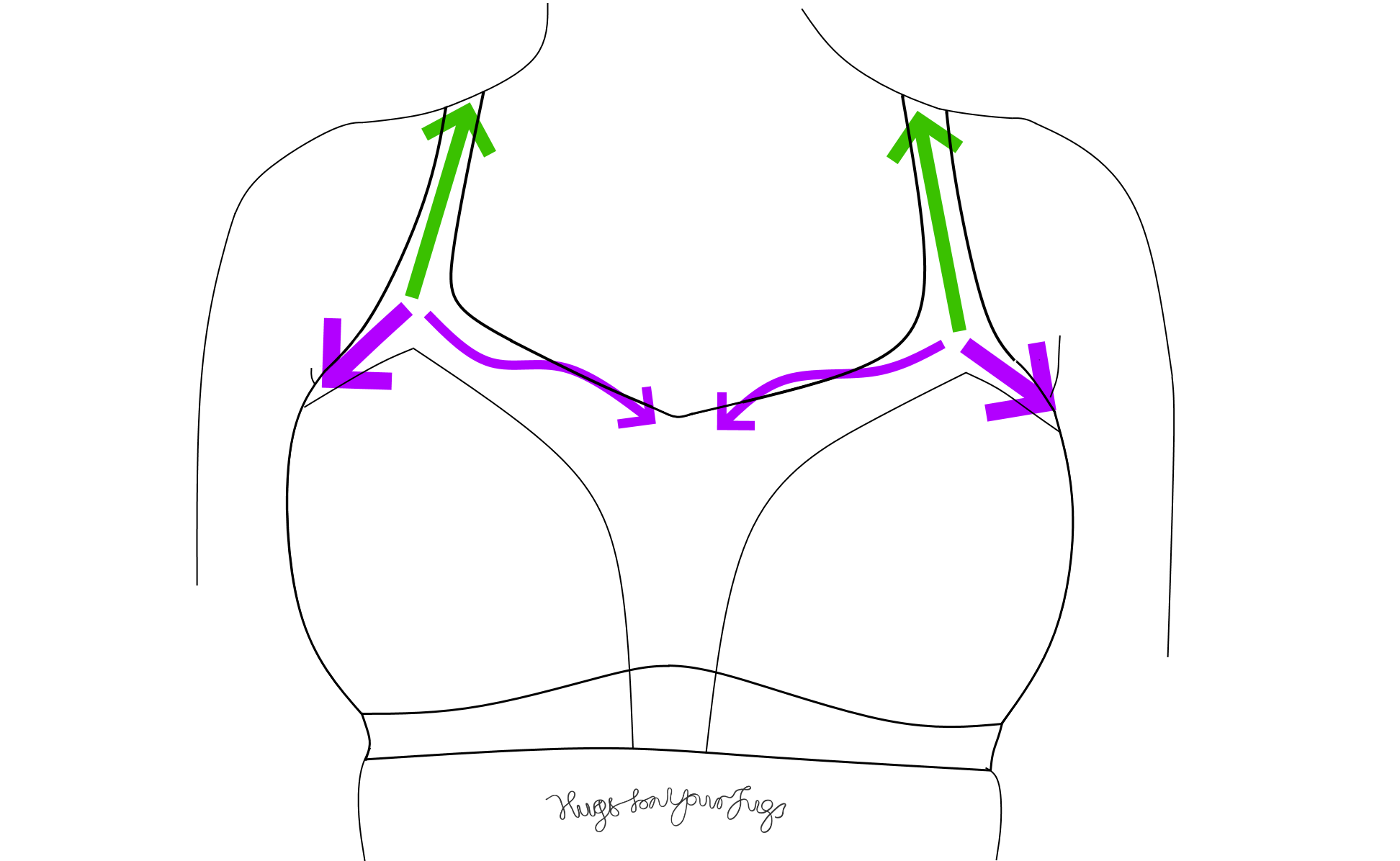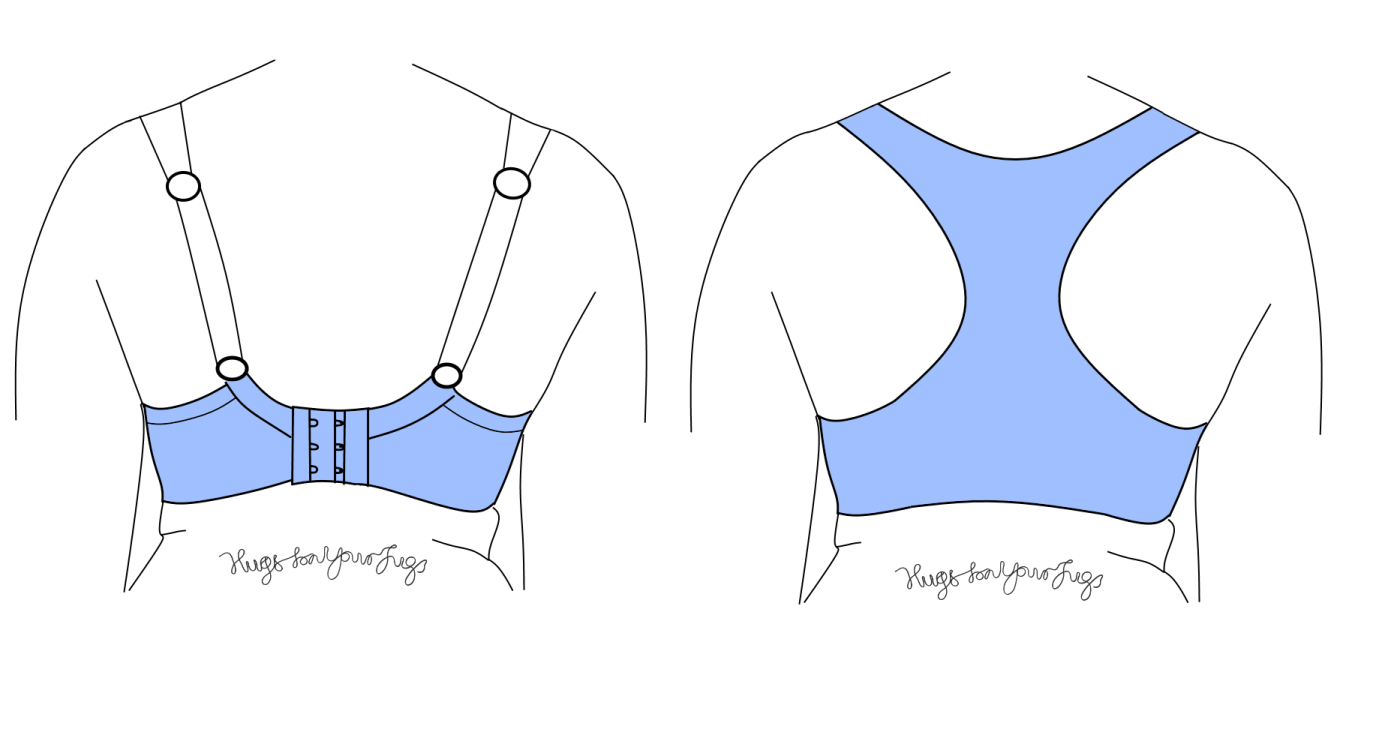Are Racerback sports bras better? Understanding strap configurations
There are so many different strap configurations in sports bras that
it's almost impossible to categorise them all. From standard T and U
backs to racerbacks, J hooks, cutout racerbacks, decorative multi
straps, what should you choose? Is there a physical reason why these
strap styles are so popular, or is it just fashion?
In this post,
I will be referring to all styles that connect or cross in the back as
racerbacks, and standard U or T backed straps as standard straps.
This post was released early to my lovely supporters on Ko-fi. To get early access to posts, or access to extended editions of posts, you can support me for just £2/$3 a month!
What the studies say
 |
Yes,
there's research into sports bras! in fact, multiple research teams
have pitted sports bras against each other to test which features are
most effective, and unfortunately the results vary quite a bit. While
some (Zhou et al., 2013) have found that bras with a "cross back panel" (like style 4 in the image above) are most effective at reducing bounce, a multiple
regression analysis performed of a much larger sample of sports bras (98 as opposed to Zhou's 7) (Norris et al., 2020) indicated that "strap
configuration showed minimal effect on sports bra performance".
Additionally, other research (Coltman et al., 2015) has found that while racerbacks and
cross-backs feel more secure to users, the same pressure from a racerback strap is more uncomfortable
than from a standard strap, probably due to its position in relation to
the traps.
My belief, based on this data and from my own
experience making and fitting bras, is that due to the variation in strap
designs that can all considered "racerback", there's multiple variables at play
here which each have their own impact on comfort, bounce reduction, and support.
If I were shopping for or designing a sports bra, these are the things I
would take into consideration.
Strap positioning and trap pain
 |
The straps of racerback styles can sit closer to the neck than standard bras, and with that comes the potential for pain in the trapezius muscles. Wider straps, padded straps, and straps positioned more widely on the shoulder are less likely to cause pain, according to research.
Strap angles and bounce control
To
reduce bounce, the neckline of a sports bra must be taut - this prevents
the upwards motion of the breast. The straps pull on the cups and
neckline of the bra, and can provide some of this tension. The rest is provided by the band - especially in compression and combination style bras, where the whole bra sits tightly on the breasts.
 |
The vertical straps pull evenly on both sides of the neckline |
When a strap is vertical, it must pull equally to the left and right, providing equal tension on the inner half and outer half of the cup.
 |
Straps that are angled towards the neck pull less on the neckline, potentially reducing bounce control in this region. |
However, a
racerback strap may pull at an angle, bringing tension off the inner
neckline and allowing breast tissue to bounce out of the centre front. I should say now that all of this is my own conjecture - no studies have been performed testing out bra strap orientations that also measured both band and strap pressure (you can see why band snugness is important below).
In my experience, these issues are especially prevalent in bras with a J hook conversion, but also in bras with a high attachment point for the racer backs. Consider choosing a bra with a more vertical strap angle for a potentially reduced bounce.
Racerback impact on band tightness
The vertical tension sacrificed by angled straps is instead turned into horizontal tension, which essentially means that the straps in a racerback bra can therefore be considered as adding to the snugness of the band.
 |
The more angled the straps are, the less vertical tension and more horizontal tension they can produce |
It's understandable then why racerback or cross-strap varieties make users feel more "locked in" than regular strapped sports bras, as the entire bra will sit more snugly around the body. Something else to consider is that many sports bras are S-M-L sized, so band snugness can be lacking in those with larger cups and smaller bands. In a way, it's as though you may be sacrificing direct bounce control for increased overall snugness.
An additional point to consider is that compression based sports bras rely heavily on this horizontal tension to function, so a racerback style could be the better choice here. If you're unsure if extra band tension will help with your bra's bounce control, look at the cups from the side. A band that sits level with the top of your breasts (or near the top) should provide better bounce control. Incidentally, this may be why larger breasts bounce less with encapsulation sports bras - larger breasts take up a larger area on the body and cannot be as easily compressed by the bands, which are limited in height due to the armpit.
Bounce control may not be what you need to reduce pain
Vertical breast displacement - that is, the amount your breasts bounce, has long been used by research departments as the way to measure sports bra efficacy. It is strongly correlated with breast pain, but is it actually the right variable to be looking at? McGhee and Steele (2010) found that breast discomfort may be better controlled by focusing on breast elevation and compression in large breasted women rather than vertical breast displacement or velocity.
While trying on sports bras, it may be worth closing your eyes and focusing more on how a bra feels than how it appears to control bounce.
Back coverage level
The wider the suppportive components of a bra - the straps and band - the more supportive they are due to the increased resistance to stretch. Racerback bras typically have higher coverage on the back than standard strapped bras, which will mean the straps themselves can stretch less, as well as the band of the bra stretching less. This may be useful for controlling bounce, however other design features can achieve this as well - such as wider hooks and eyes and using band and cup sizing as opposed to S-M-L sizing systems.
Strap security and movement
Bounce
control isn't the only important feature of a sports bra - you need to
be able to move, stretch, and run comfortably and feel as though your sports bra will move with you. A bra where the straps connect in the back can absolutely
feel more secure, especially for those with sloping shoulders, as they
can't fall down.
It's important to think about the potential
role that a too loose band and non-adjustable straps might be playing in
this scenario, however. Based on my experience, and given an appropriately sized band and adjustable straps, I believe most people
would not face the problem of straps falling down during running and similar movements.
For
other exercises that involve more shoulder movement and twisting,
straps that go across your spine may be a more appropriate choice.
Adjustability, strap width, and padding
It probably goes without saying that adjustable straps on a sports bra are more comfortable and effective as they can be adjusted to fit perfectly. In particular, some styles have locking straps made out of velcro or a "ladder" style attachment, ensuring they won't slip during exercise. However, many racerback bras have nonadjustable straps, so this is a feature you may need to spend more time searching for.
On the other hand, racerback straps are often
wider than their regular strapped counterparts (although padding seems a
rarer choice on them). Wider straps and
padding can have a big impact on comfort, although do not appear to reduce bounce (Coltman et al., 2015).
In conclusion
If you've ever tried a racerback conversion clip and been disappointed with the subsequent loss in bounce control, I hope you can understand why this might have been the case! As it goes, there's a lot of variability in sports bra design, so understanding your personal needs and trying as many as youcan is the best way of finding something right for you.
There's no definitive answer to whether racerback sports bras are better, as improving overall snugness and strap security comes with some potential tradeoffs. In my opinion, the most important features in a sports bra revolve around finding one that fits you best rather than fitting multiple people: cup and band sizing, adjustable straps, and fabrics that maintain high tension when stretched - the rest is just a matter of trial and error.
Bibliography
Coltman, C. E., McGhee, D. E., & Steele, J. R. (2015). Bra strap orientations and designs to minimise bra strap discomfort and pressure during sport and exercise in women with large breasts. Sports medicine-open, 1(1), 1-8.
McGhee, D. E., & Steele, J. R. (2010). Breast elevation and compression decrease exercise-induced breast discomfort. Medicine and science in sports and exercise, 42(7), 1333-1338.
Norris, M., Blackmore, T., Horler, B., & Wakefield-Scurr, J. (2020). How the characteristics of sports bras affect their performance. Ergonomics, 64(3), 410-425.
Zhou, J., Yu, W., & Ng, S. P. (2013). Identifying effective design features of commercial sports bras. Textile Research Journal, 83(14), 1500-1513.


Zgadza się ważny jest odpowiedni dobór biustonosza :)
ReplyDeleteOwning a white basic is great for when you have white colored clothing and semi-sheer blouses. But make sure you try on bra colors that are closest to your skin shade for thinner white clothing.
ReplyDeleteundergarments for women